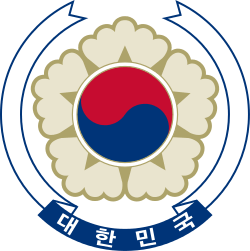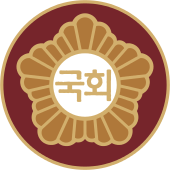List of political parties in South Korea
 |
| This article is part of a series on the politics and government of South Korea |
| Constitution |
|
Judiciary 
|
This article lists political parties in South Korea. South Korea has a weakly institutionalized multi-party system,[1][2] characterized by frequent changes in party arrangements. Political parties have a chance of gaining power alone.
Current parties
Main parties
Following the 2016 legislative election, four political parties will be present in the 20th National Assembly:
| Party | Assembly seats |
Party leader | Floor leader | Position | Ideology | Comments | Status | |
|---|---|---|---|---|---|---|---|---|
| Saenuri Party (SP) 새누리당 Saenuridang |
129 | Park Geun-hae | Chung Jin-suk | Centre-right [3][4][5][6][7] to Right-wing[8][9] |
Conservatism | see: Conservatism in South Korea Conservative; formerly called the Grand National Party. |
Ruling party | |
| Democratic Party of Korea (DPK) 더불어민주당 Deobureo minjudang |
122 | Choo Mi-ae | Woo Sang-ho | Centre to Centre-left [10][11] |
Social liberalism | see: Liberalism in South Korea Liberal; merged from the Democratic Party and the minor New Political Vision Party. |
Opposition | |
| People's Party (PP) 국민의당 Gungminuidang |
38 | Park Jie-won | Park Jie-won | Centre | Centrism | see: Liberalism in South Korea Liberal; splintered from the Minjoo Party of Korea. | ||
| Justice Party (JP) 정의당 Jeonguidang |
6 | Sim Sang-jung, Na Gyung-che, Kim Se-kyun, | Roh Hoe-chan | Left-wing | Progressivism | See: Progressivism in South Korea Progressive; splintered from the Unified Progressive Party | ||
Notes:
- The total number of representatives is 300.
- 5 elected representatives are independents.
Extra-parliamentary parties
- Labor Party (노동당, Nodongdang)
- Christian Liberal Party (기독자유당; Gidok jayudang)
- Green Party Korea (녹색당, Noksaekdang)
- Hannara Party (한나라당, Hannaradang)
- Minjoo Party (민주당, Minjudang)
- People's New Party for Reform (개혁국민신당, Gaehyeok gukminsindang)
- People's United Party (민중연합당, Minjung yeonhapdang)
- Green Buddhist United Party (그린불교연합당, Geurin bulgyo yeonhapdang)
- International Green Party (국제녹색당, Gukje noksaekdang)
- Republican Party (공화당, Gonghwadang)
Defunct parties

Timeline of all mainstream political parties
Conservative parties
Main article: Conservatism in South Korea
Mainstream parties
- National Alliance for the Rapid Realization of Korean Independence (1946-1951)
- Liberal Party (1951–1960)
- Democratic Republican Party (1963–1980)
- Democratic Justice Party (1981–1990)
- Democratic Liberal Party → New Korea Party (1990–1997)
Minor parties
- Korean Resistance Party (1945–1950)
- Federation Korean National Independence (1947-1951)
- Korea National Party (1947-1958)
- Democratic Unification Party (1973–1980)
- Korean National Party → New Democratic Republican Party (1981–1990)
- United People's Party → Democratic Party (1992-1995)
- United Liberal Democrats (1995–2006)
- People First Party (2005–2008)
- Liberty Forward Party → Advancement Unification Party (2008-2012)
- Pro-Park Coalition → Future Hope Alliance (2008-2012)
Liberal parties
Main article: Liberalism in South Korea
Mainstream parties
- Korea Democratic Party → Democratic National Party (1945-1955)
- Democratic Party (1955-1961)
- Civil Rule Party (1963-1965)
- People's Party → New Democratic Party (1965–1980)
- Democratic Korea Party (1981-1988)
- New Korea Democratic Party (1984–1988)
- Reunification Democratic Party (1987–1990)
- Party for Peace and Democracy → Peaceful Democratic Party (1987–1991)
- Democratic Party (1991–1995)
- National Congress for New Politics (1995-2000)
- Millennium Democratic Party → Democratic Party (2000–2008)
- The People's Party for Freedom → Uri Party (2002–2007)
- United New Democratic Party (2007–2008)
- United Democratic Party → Democratic Party (2008–2011)
- Democratic United Party → Democratic Party (2011–2014)
Minor parties
- Democratic Party (1963-1965)
- Democratic Party (1990–1991)
- Democratic Party (1995–1997)
- The Participation Party (2010-2011)
- New Political Vision Party (2014)
- Minjoo Party (2014-2016)
Progressive parties
Main article: Progressivism in South Korea
- Preparatory Committee for National Construction → People's Party of Korea → People's Labor Party (1945-1950)
- Workers' Party of South Korea (1946-1953)
- Socialist Party (1951-1953)
- Progressive Party (1956-1958)
- United Socialist Party of Korea (1961 ~ 1967)
- Hangyore Democratic Party (1988-1991)
- People's Party (1988)
- The People's Party (1990-1992)
- People's Victory 21 → Democratic Labor Party (1997-2011)
- Youth Progressive Party → Socialist Party → Korea Socialist Party → Socialist Party (1998–2012)
- New Progressive Party (2008–2012)
Green parties
- Korea Greens (2004-2008)
Banned parties
- Progressive Party (1956-1958)
- Anti-Imperialist National Democratic Front (1969-1985)
- National Democratic Front of South Korea (1985-2005)
- Democratic Labor Party + The Participation Party → Unified Progressive Party[12] (2011-2014)
See also
References
- ↑ Wong, Joseph (2015). "South Korea's Weakly Institutionalized Party System". Party System Institutionalization in Asia: Democracies, Autocracies, and the Shadows of the Past. Cambridge University Press. pp. 260–279.
- ↑ Wong, Joseph (2012). "Transitioning from a dominant party system to multi-party system: The case of South Korea". Friend or Foe? Dominant Party Systems in Southern Africa: Insights from the Developing World. United Nations University Press. pp. 68–84.
- ↑ Manyin, Mark E. (2003), South Korean Politics and Rising "Anti-Americanism": Implications for U.S. Policy Toward North Korea (PDF), Congressional Research Service
- ↑ The Economist, print edition, April 11, 2008, South Korea's election: A narrow victory for the business-friendly centre-right, Accessed Oct 19, 2013.
- ↑ Cronin, Patrick M. (2009), Global Strategic Assessment 2009: America's Security Role in a Changing World, INSS
- ↑ Global Security: Japan and Korea; Tenth Report of Session 2007-08, House of Commons of the United Kingdom, 2008
- ↑ Klassen, Thomas R. (2013), Korea's Retirement Predicament: The Ageing Tiger, Routledge, p. 12
- ↑ Oum, Young Rae (2008), Korean American diaspora subjectivity: Gender, ethnicity, dependency, and self-reflexivity, ProQuest, p. 144
- ↑ Routledge Handbook of Criminology
- ↑ Kang, Jiwon (2014-03-02). "[강지원의 뉴스! 정면승부] "국가지도자 추구하는 안철수, 의원 2명인 곳에서 뜻 펼치긴 어려워"-민주당 설훈 의원" (in Korean). YTN. Retrieved 2014-04-01.
- ↑ Chae, Jongwon (2014-03-31). 안보·경제민주화 양축…金·安 공동대표 가능성 (in Korean). Maeil Economy. Retrieved 2014-04-01.
- ↑ Yonhap News Agency, December 19, 2014, , “...South Korea's Constitutional Court on Friday ordered the dissolution of a pro-North Korean minor opposition party...”
- The present state of registered political parties, National Election Commission of S. Korea.
- The present state of political parties registration, National Election Commission of S. Korea, May 29, 2008.
This article is issued from Wikipedia - version of the 12/4/2016. The text is available under the Creative Commons Attribution/Share Alike but additional terms may apply for the media files.

